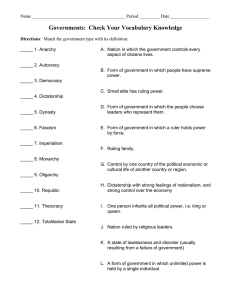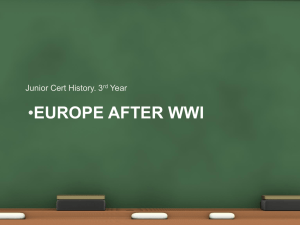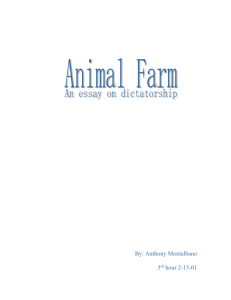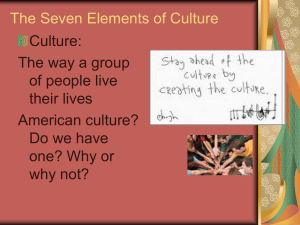SOCIAL MOVEMENTS
advertisement
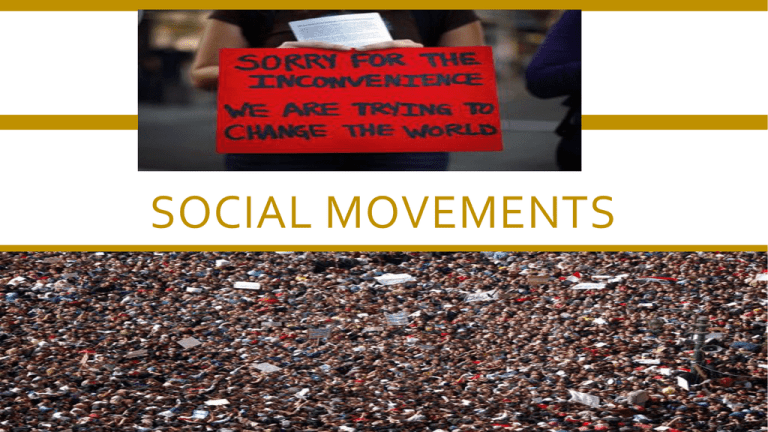
SOCIAL MOVEMENTS SOCIAL MOVEMENT Collective action Civil society (ordinary people) confronting authority to bring about social change By people who do not have access to mainstream sources of power Not a single event / demonstration Goal is to create CHANGE and to put issue in public eye; on the agenda TWO CASE STUDIES: 1. Landless Workers Movement , Brazil 2.Las Madres y Abuelas, Argentina 1. LANDLESS WORKERS MOVEMENT (MST) Rural workers fighting for land reform and social equality in rural areas, Brazil Strategy: Occupy latifundios Since 1984: 2500 land occupations, 370,000 families Currently: 900 encampments holding 150,000 families MILITARY DICTATORSHIP 1964 - 1985 Coup led by Armed Forces, backed by US New Constitution; repressed free speech and political opposition censored media, tortured and disappeared (murdered) dissidents Nationalism, economic development and anti-Communism were main themes of dictatorship Created a model adopted by other dictatorships in LA (Chile, Argentina): military’s actions are justified in the name of “National Security” AFTERMATH OF DICTATORSHIP Concentration of power (= LAND in countryside) 50 % of land owned by 1 % of population Modernization of agriculture Mass exodus to cities from rural areas Of salaried farmworkers, shareholders, renters In various states of Brazil, rural workers began to organize to reclaim their rights to work the land Became part of push for democracy across the country “Land for those who work it” “Without land reform there is no democracy” BRAZILIAN CONSTITUTION challenges notion of “private property” rights Article 184: All land should serve a social function. The constitution requires the Brazilian government "to expropriate for the purpose of agrarian reform, rural property that is not performing its social function." Article 186 the social function means : (1) rational and adequate use; (2) adequate use of available natural resources and preservation of the environment; (3) compliance with the provisions which regulate labor relations; and (4) exploitation which favors the well-being of the owners and workers." MST occupies unproductive, unused rural land that it does not believe is meeting its social function to remind the federal government of its constitutional responsibility. Then a legal process starts to expropriate the land and grant title to the landless workers. The landowners usually try to evict the families. 2. LAS MADRES, ARGENTINA DIRTY WAR Lasting legacy on Argentine society Silent; secret; unknown for many years Began before the military dictatorship by junta Under National Reorganization Process: Kidnapping, torture, murder were legal For purpose of restraining subversives Ideological war: • asked citizens to give up individual rights to “cleanse” the country of subversives and achieve peace for “God and country” • steady propaganda campaign: enemy is unknown; enemy is among you 350 detention centers Size: 30 – 1500 prisoners Abducted day or night; family members beaten; children kidnapped Local police assisted Used psychology of fear OPERATION CHARLY 1977-1984; covert Junta shared methods of repression and torture with governments/groups in Central America Encouraged by US IN DETENTION…. Blindfolded Nicknames Tortured Sexually abused Burned with cattle prods Hitler’s speeches broadcast Many died and were buried in mass graves Many were drugged, transported in planes, and dropped over ocean alive Many disappeared: no records LOS DESAPARECIDOS 30,000 in Argentina in 7 yrs Not including those released Families desperately searched 400 babies born in captivity 88 found true identities (as of 2008) MADRES Y ABUELAS DE LA PLAZA DE MAYO Began in hope that children would be released Met in secret; learned of enormity of situation Meet in Plaza de Mayo on Thursdays FALKLANDS/MALVINAS Battle with British for control; lost to British in 1982 Final test of the dictatorship Raúl Alfonsin came to power in December 1983 3 days after election, passed Decree #158: Legal proceedings against 9 military officials of 3 of 4 military juntas (4th junta had passed a self-amnesty law) ALFONSIN 1983 Created CONADEP: National Commission on the Disappearance of Persons Investigate human rights violations during dictatorship Released report 1984 (Nunca Más): 458 assassinations; 600 disappeared Trial of junta Life imprisonment of 9 members of junta Alfonsin also felt pressure to pacify military 1. 1986 Ley de Punto Final (Full Stop Law) Mandated end of investigation & prosecution for those facing charges for political violence under dictatorship up to 1983 2. 1987 Ley de Obedencia Debida (Law of Due Obedience) officers cannot be punished for political violence during dictatorship because they were following orders CARLOS MÉNEM 1989 Pardoned officers who had been indicted Human rights groups sought justice, testimony from victims, loopholes in law Mid-level officers began confessing to atrocities Pressure from Madres & civil society for “truth trials” Courts had right to subpoena and investigate but not to convict International pressure 1999 Inter-American Commission on Human Rights settled with Argentina to guarantee “right to truth by obtaining clarification of what happened to disappeared persons” Full Stop Law and Law of Due Obedience did not pertain to baby theft Ménem created National Commission for Right to Identify 1992 Some military generals (e.g. Videla)were found guilty of kidnapping babies Spent 1 month in jail; released to house arrest for health reasons Other countries (Italy, Spain) called for extradition of military junta members so they could be tried abroad President Fernando de la Rúa signed Decree 1581 Argentina refused to allow Argentines to stand trial in other countries Full Stop and Due Obedience Laws were found unconstitutional by Supreme Court 2005 2006 cases were reopened Those previously pardoned could not be retried 1 early case led to calling dictatorship’s actions “genocide” Earlier pardons were therefore unconstitutional 2007 Argentine federal court struck down Ménem’s pardons and reinstated human rights abuse allegations CIVIL SOCIETY HAS BEEN RALLYING FACTOR IN THIS STRUGGLE FOR JUSTICE Change has been made due to their fight and pressure Proyecto Desaparecidos (Project Disappeared) Several human rights organizations “with the purpose of recovering and maintaining memory, understanding what happened in Argentina during the dirty war and fighting against impunity” Monuments to remember the dead Monument of the Victims of State Terrorism Began in 1999 with 1 stone R S
